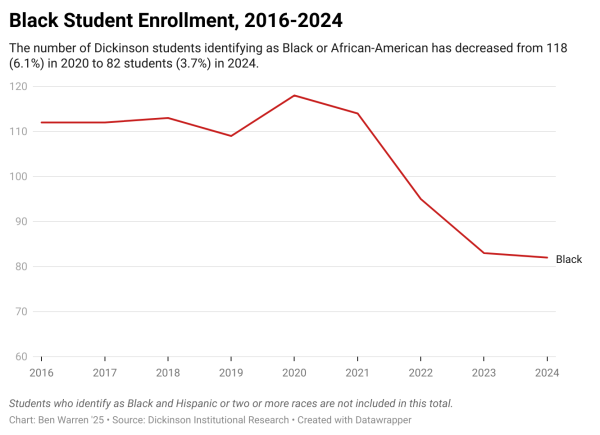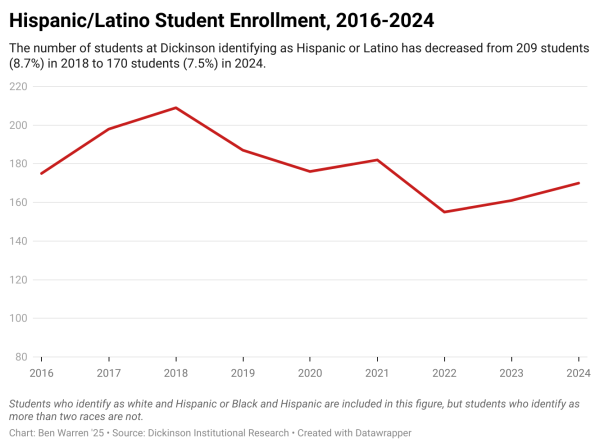Editor’s note: This article was published in print as “Class of 2028 more diverse despite fewer Latino, international students.” Since the print edition was finalized, the college’s enrollment division confirmed that the original data it provided to The Dickinsonian incorrectly classified Hispanic or Latino students who also selected another racial identification as “two or more races” as opposed to “Hispanic or Latino.” The updated article corrects this error.
Dickinson’s class of 2028 is more racially diverse than last year’s incoming class, though enrollment by international students dropped by more than half.
U.S.-born white students now make up the largest proportion of the student body since the 2016-2017 academic year, nearly 67%.
“Although the Supreme Court’s decision prohibits the use of race as a determining factor in our decision-making process, our commitment to maintaining a vibrant, diverse and inclusive community remains steadfast,” Greg Moyer ’06 and Molly Boegel, Associate Vice Presidents for enrollment, told The Dickinsonian in an email.
After last year’s U.S. Supreme Court decision sent colleges around the country scrambling to assemble racially diverse classes, admissions officers at Dickinson increased their focus on recruiting students from New England and the mid-Atlantic, where Dickinson students are most likely to come from.
“That focus, which includes diverse metropolitan areas such Boston, New York [City], Philadelphia and Baltimore led to an increase in interest from students, including students from traditionally underrepresented backgrounds,” Moyer and Boegel wrote.
First-year enrollment by Black students at the College more than doubled from last year’s incoming class and the proportion of Hispanic or Latino students stayed roughly the same.
This defies patterns at colleges like the Massachusetts Institute of Technology or Amherst College, where the number of Black students in the first-year class dropped significantly.
Enrollment among Black and Latino students across all years at the college continues to decline, however.
In the 2020-2021 academic year, 6% of Dickinson students identified as Black and 9% as Hispanic or Latino. This year, fewer than 4% identify as Black and 7.5% as Hispanic or Latino.
The college’s initial report – based on data collected during the pre-orientation process – incorrectly classified 37 Hispanic or Latino students as multi-racial. The updated numbers are based on data collected via the Common Application, the same way demographic information has been collected in the past.
Boegel confirmed that the enrollment and institutional research divisions at the college are working to update the class profile data.
The Class of 2028 also includes the lowest number of international students since the Class of 2024 enrolled at the height of the COVID-19 pandemic.
Students from nations like Vietnam, South Korea and Nepal had enrolled at Dickinson at increasingly higher rates, making up nearly 15% of last year’s first-year class. This year, students from non-U.S. high schools were less than half that.
Overall, enrollment in this year’s first-year class outpaced expectations: it is the largest group of new students since before the COVID-19 pandemic and represents a 25% increase over last year’s class.
Most of that increase came in the form of 467 white students from U.S. high schools, the largest such cohort since at least 2016.
Boegel and Moyer said, “While the college strives to build a diverse, inclusive environment, the numbers of students from certain racial or ethnic backgrounds at Dickinson will always fluctuate from year to year depending on who applies.”













